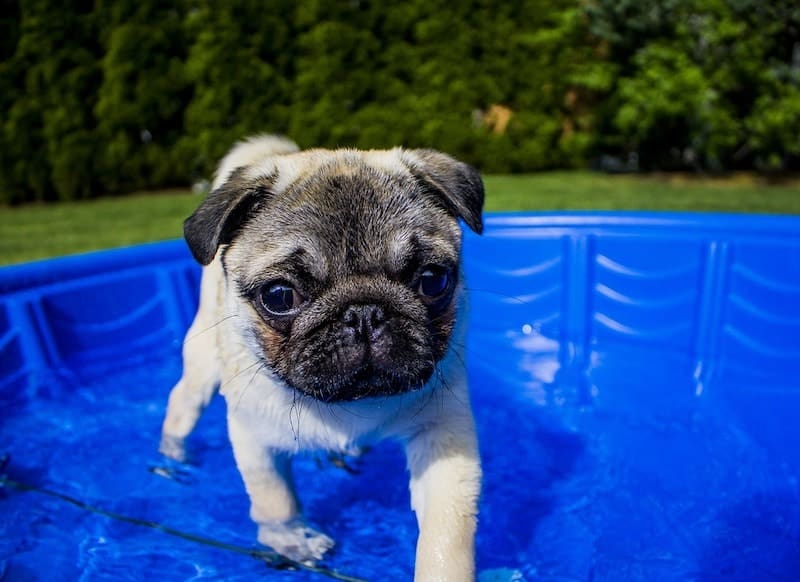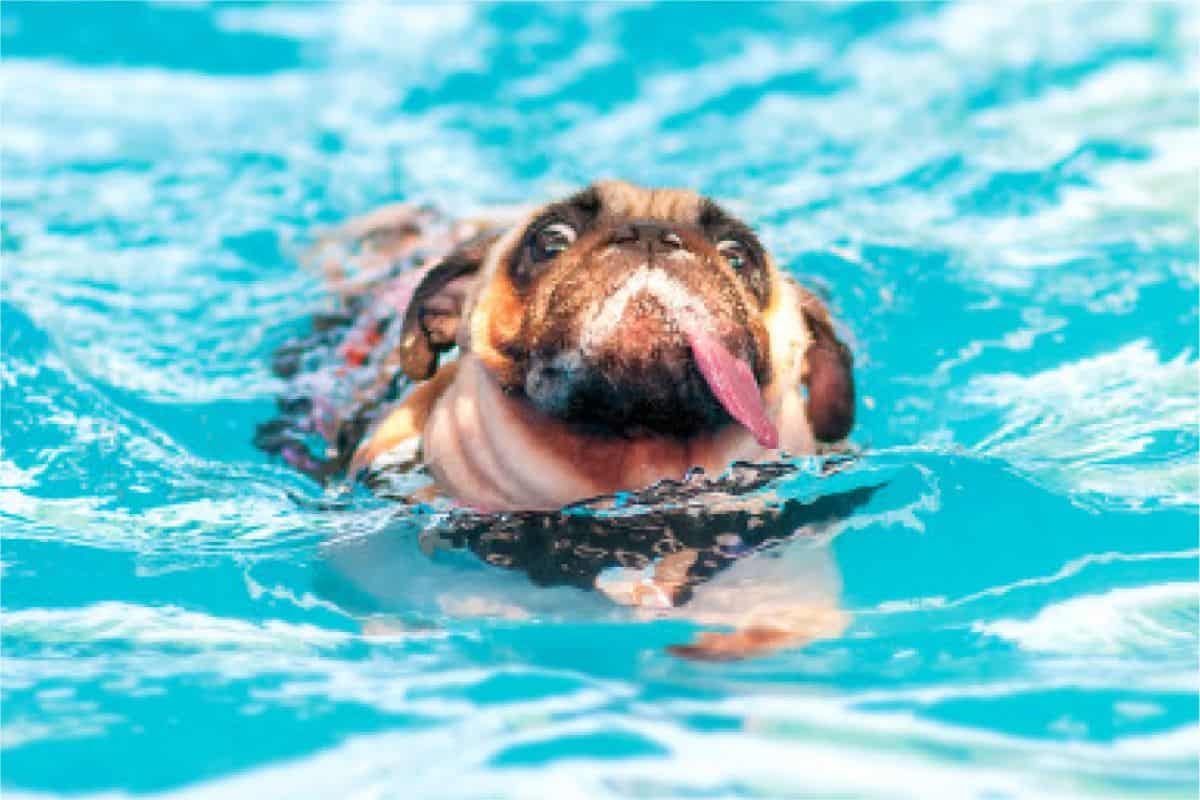Pugs, adorable and charming as they may be, are not built for swimming. There are several reasons why pugs cannot swim, primarily related to their unique facial structure and body proportions. Understanding these reasons is crucial for pug owners to ensure the safety and well-being of their beloved pets.

One of the main factors that contribute to pugs' inability to swim is their facial structure. Pugs have short snouts and flat faces, a characteristic known as brachycephaly. This facial structure limits their ability to breathe efficiently, making it challenging for them to keep their heads above water while swimming.
Pugs have a compact body shape with short legs and a relatively large head compared to their body size. This body proportion makes it difficult for them to paddle their legs effectively and maintain buoyancy in the water. As a result, pugs may struggle to stay afloat and may tire quickly when attempting to swim.
The risks associated with pugs trying to swim are substantial. Firstly, their brachycephalic structure makes them prone to breathing difficulties and respiratory issues when submerged in water. Pugs may struggle to take in enough air, leading to respiratory distress and the risk of drowning.

Furthermore, pugs can easily become fatigued and experience muscle strain when attempting to swim. Their body shape and proportions make it hard for them to sustain physical exertion in the water, which can result in exhaustion and even muscular injuries.
Lastly, pugs are susceptible to hypothermia when exposed to cold water for prolonged periods. Their short coats provide little insulation, making it challenging for them to regulate body temperature in colder water conditions.
As responsible pug owners, it is essential to consider these limitations and take appropriate measures to keep our pugs safe. Providing alternative water activities that do not involve swimming, such as shallow water play, can still offer enjoyment for pugs while minimizing risks. Ensuring safety measures around water sources and closely supervising pugs near water will help prevent accidents and potential harm.
By understanding why pugs can't swim and taking proactive steps for their well-being, pug owners can confidently enjoy their time with these lovable pets without compromising their safety.
Key takeaway:
- Pugs can't swim due to their facial structure and body shape: The short snouts and compact, dense bodies of pugs make it difficult for them to stay buoyant and navigate in water.
- Risks of pugs trying to swim include breathing difficulties, fatigue, and hypothermia: Pugs are prone to respiratory issues, which can worsen when they try to swim. Their short legs and limited stamina also put them at risk of exhaustion and hypothermia in cold water.
- Pug owners should consider alternative water activities and ensure safety: Instead of swimming, pugs can enjoy water play with shallow pools or supervised water sprinklers. It's important to keep them away from deep water and always provide appropriate safety measures.
Why Can't Pugs Swim?
Ever wondered why pugs can't swim? Let's dive into the peculiarities of their facial structure and body shape that prevent them from taking a graceful plunge. From their adorable squished faces to their compact proportions, we'll uncover the surprising reasons behind their aquatic inability. So, join me in exploring the fascinating world of pugs and unravelling the mysteries of their aquatic aptitude, or lack thereof!
Facial Structure
The facial structure of pugs is one of the main reasons why they can't swim effectively. Pugs have short snouts and flat faces, which can make it difficult for them to breathe properly in water. Their brachycephalic features, including limited nasal passages, result in less efficient inhalation and exhalation. The flatness of their faces also predisposes them to water entering their nostrils and obstructing their airways. These anatomical characteristics increase the risk of breathing difficulties and potential drowning if pugs are not closely monitored around water.
Fact: Pugs are known to be excellent companions and are often referred to as "clowns" due to their playful and mischievous nature.

Body Shape and Proportions
Pugs have a unique body shape and proportions that can make swimming challenging for them. Due to their short legs and large, round bodies, pugs may struggle to stay afloat in the water. Moreover, their short snouts and flat faces can lead to breathing difficulties if they become submerged. The combination of these factors increases the likelihood of pugs facing risks such as drowning, exhaustion, and hypothermia while attempting to swim. As responsible pug owners, it's crucial to comprehend and respect their limitations, avoiding water activities that may put them in danger. Instead, offering alternative water options like shallow wading pools or supervised water play can ensure pugs' safety while still enabling them to enjoy the benefits of being in the water.
What Are the Risks of Pugs Trying to Swim?
When pugs take a plunge, they face a range of risks that can lead to serious consequences. From breathing difficulties and fatigue to the lurking threat of hypothermia, these perils make swimming a treacherous endeavor for these adorable pooches. Let's take a closer look at the potential hazards pugs encounter when they dip their paws in the water, shedding light on the importance of understanding these risks to ensure the safety and well-being of our beloved four-legged friends.
Breathing Difficulties and Respiratory Issues
Pugs are more prone to experiencing breathing difficulties and respiratory issues compared to other breeds. This is mainly due to their short noses and compressed airways, which make it challenging for them to breathe properly. As a result, swimming becomes a struggle for them. When pugs attempt to swim, they may face respiratory distress, putting them at a higher risk of inhaling water and potentially drowning. Therefore, it is crucial for pug owners to be aware of these specific issues and refrain from exposing their beloved pets to situations that could potentially worsen their breathing difficulties. By taking necessary precautions and offering alternative water activities, pugs' safety and overall wellbeing can be ensured.
Fatigue and Muscle Strain
Fatigue and muscle strain are typical hazards that pugs encounter while attempting to swim due to their physical limitations. Because of their short legs and limited endurance, they are prone to exhaustion, leading to muscle strain and potential injuries. Pug owners can take the following measures to prevent these issues:
- Regularly monitor the energy levels of their pugs and limit swimming sessions to avoid excessive fatigue.
- Provide pugs with a floating device or life jacket specifically designed to support them in the water.
- Ensure that the water is not too cold, as cold temperatures can cause increased muscle tension and strain.
- Offer frequent breaks during swimming to allow the pug to rest and recover.
- Consider engaging in alternative water activities that are less strenuous, such as playing in shallow water or using a doggy pool.
By being mindful of fatigue and muscle strain, pug owners can ensure the safety and well-being of their beloved pets.
Hypothermia
Hypothermia is a serious risk for pugs attempting to swim due to their inability to regulate body temperature efficiently. Water that is colder than their body temperature can quickly lower their body temperature, leading to symptoms such as shivering, weakness, and disorientation. Without prompt intervention, these symptoms can progress to life-threatening situations. Therefore, it is essential for pug owners to be aware of the risk of Hypothermia and ensure that their pugs do not spend prolonged periods in cold water. On a lighter note, it is interesting to know that pugs are known for their love of warmth and enjoy snuggling up in blankets to stay cozy.

Other Considerations for Pug Owners
Pug owners, let's dive into some important factors to consider besides swimming when it comes to our adorable furry friends. Discover exciting alternatives for water activities that will surely keep your pugs entertained. We'll explore essential measures to ensure the safety of our beloved pugs around water. With these helpful insights, you can provide your pug with a wonderful and safe water experience. So, let's dive in and explore!
Providing Alternative Water Activities
It is crucial to provide alternative water activities for pugs to keep them engaged and ensure their safety. Here are some suggestions:
- Ensure your pug's enjoyment and cooling off by filling a small kiddie pool with a few inches of water for them to play in.
- Set up a sprinkler in the yard and let your pug run through it, offering them a fun way to stay cool.
- Invest in floating toys or water-safe balls that your pug can chase and retrieve, providing them with entertainment in the water.
- Engage your pug in a gentle game of tug-of-war or hide and seek using a dampened towel for interactive play.
- For supervised swimming activities, consider acquiring a water-resistant vest or life jacket to ensure your pug's safety.
Ensuring Safety around Water
- Always supervise your pug when they are near water, whether it's a pool, lake, or bathtub.
- Secure fencing: Install a secure fence around your pool or any other bodies of water in your yard to prevent your pug from accidentally falling in.
- Life jackets: Consider using a canine life jacket when taking your pug near bodies of water to ensure their safety in case of accidents.
- Training: Teach your pug basic commands like "come" and "stay" to prevent them from wandering too close to water without permission.
Remember, pugs are not natural swimmers, so taking these precautions will help ensure their safety around water.

Frequently Asked Questions
Can pugs swim?
Yes, pugs can swim, but there are factors that make it difficult for them.
What are the physical and temperamental reasons why pugs struggle with swimming?
Pugs have short legs and an elongated body, which hinders their swimming abilities. Their smushed faces and shortened muzzles also make it difficult for them to breathe properly in the swimming position.
Are pugs designed for swimming?
No, pugs are not naturally designed for swimming. They do not have webbing between their paws, and their legs and feet are not adapted for efficient swimming.
Do pugs enjoy being in the water?
Not all pugs enjoy being in the water. Some may show signs of enjoying swimming, such as sniffing floaties or wagging their tail at sunbathers. However, every happy dog is different, and some pugs may not have an interest in swimming.
How can pugs be taught to swim?
Pugs can be taught to swim with patience and gentle introduction to water. It is important to ensure the swimming venue is safe and appropriate for them, with clear water and a comfortable temperature.
What safety measures should be taken when pugs swim?
When pugs swim, it is recommended for them to wear a life vest to ensure their safety. It is also important to pay attention to their body language and avoid forcing them if they show signs of discomfort or dislike for swimming.




